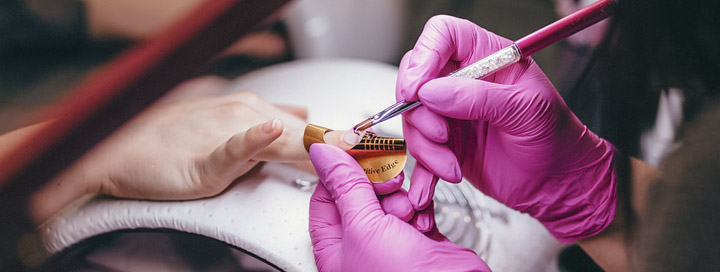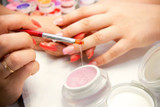What is Monomer and Polymer for Nails?
What is Monomer and Polymer for Nails?
One of the most frequently asked questions by manicure enthusiasts is what is monomer and polymer for nails. These are two chemical compounds prepared to build acrylics, let's review the difference between monomer and polymer for nails.
What is Liquid Monomer?
Nail liquids are monomers composed mainly of ethyl methacrylate (EMA) and occasionally they include other monomers and additives as well. Typically the monomer will have a purple tint, with UV inhibitors, which protects the acrylic polymer against yellowing.
This is the liquid that is used together with the polymers in order to create the paste with which we will begin to shape the nail using our own nail and paper nail forms as a mold.
Remember to use monomers and nail polymers from the same manufacturer to avoid negative results in the form of yellowing of the nails, weak or easily loose sculpting and even allergies.
What Are The Different Types Of Monomers?
These are the types of monomers that exist so far, get to know them one by one and choose the one that best suits your needs and preferences.
Slow setting:
If you are starting in this art, it is a very good option for you. As its hardening process takes more than three minutes, you will have plenty of time to work the nails, correct small defects that may appear and give them the desired shape.
Normal:
Widely used because its hardening process does not exceed two or three minutes.
Competition monomer:
It is so called because it is the one used in competitions thanks to the fact that its setting is one of the fastest. It will set in less than one minute.
Odorless:
The odor given off by monomers is strong, which is why it is recommended to perform this process in an area with good ventilation. However, this type is characterized by the fact that it is odorless.
What is Nail Polymer?
The polymer is (a powder with an acrylic base), which is the body in the creation of this peculiar "substance". When it comes into contact with the nail liquid monomer, a chemical reaction is created causing the appearance of a kind of solid clay that we can use to sculpt the nail.
It is recommended to be mixed with a monomer of the same firm, (this detail is fundamental to achieve good results).
This powder is generally used for the creation of sculpted nails, the combination of this together with the monomer is responsible for the reconstruction of nails damaged either by accidents or diseases.
Our Ema Acrylic Nail Liquid Monomer will help you achieve beautiful acrylic nails easily.
Basic Polymer Colors Used for Nail Art
These acrylic nail powders come in different shades, each of them has a special use. The basic polymer shades are:
- Natural:Used to sculpt the base of the nail.
- Pink: Used for sculpting natural looking nails.
- Crystal pink: It is perfect for sculpting the whole nail and to make the base of a French manicure.
- White: Used for a French manicure.
- Light white: This is more recommended for a natural-looking French manicure.
- Crystal: This is used for encapsulation, as well as to give a more natural look to the sculpted nail.
- Peach: It is a peach tone, a little pale. It is a very natural tone.
- Pink: It is a shade that perfectly imitates the natural look of the nail.
How to Form the Acrylic Bead?

Dip a kolinsky brush (a number 8 or 6 is recommended to start with) in the monomer, and then pick up a little polymer with the tip. When wet, the polymer will stick together forming a "pearl" of the so-called acrylic.
Then we will place this pearl in the desired part of the nail. If you are going to use paper molds to form the extension you want, place it on the natural nail and drag it over the surface until it covers the size you want to achieve.
However if you intend to use acrylic nail tips, you must first place it on top of the tip, then you just have to spread it all over the nail tip.
Tips:
The ideal would be to use a practice hand, which allows you to reproduce the original technique. As well as filing the edges and excess material and recreate the whole process from scratch.
There are also templates with circles designed to carry out this technique. Although they are really only for practicing the density of the mixture.
We encourage you to surprise your friends and family with your new skill, they will be amazed!
You May Also Like: The Ultimate Guide to Nail Tech Tipping, Salon Etiquette, and More
Recent Posts
-
▷ How to Remove Acrylic Nails | Best Pro Tips
Step-by-Step Guide to Safely Removing Acrylic Nails Hello there! I'm Daniella Fer, the proud owner
-
What is Builder Gel? | Benefits & How to Use It
Step 1: Gather Your Supplies Firstly, assemble the essentials. You’ll need ac





